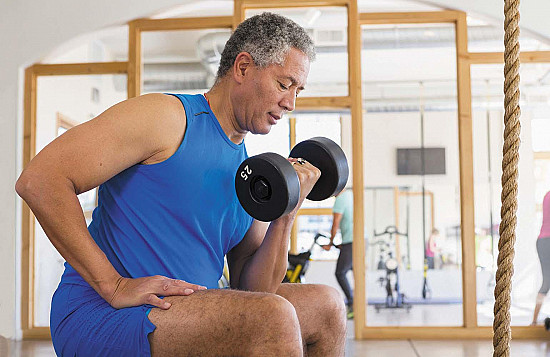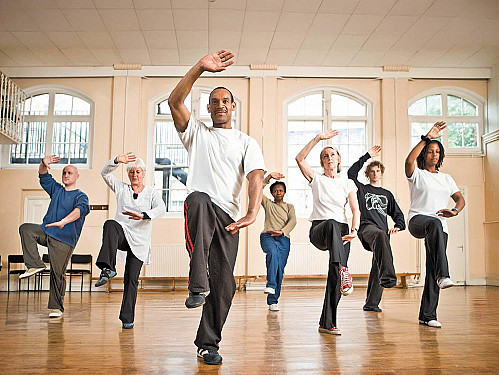How to fill out a “flat” behind
Weak gluteal muscles can increase the risk of injuries.
- Reviewed by Howard E. LeWine, MD, Chief Medical Editor, Harvard Health Publishing; Editorial Advisory Board Member, Harvard Health Publishing

Men often worry about their expanding frontside in the form of a growing belly. But they shouldn’t ignore a deflating backside, commonly known as “flat butt.” A flat butt is a sign of weak gluteal muscles and tight hip flexors. “This often happens from too much sitting,” says physical therapist Matt Murray with Harvard-affiliated Spaulding Outpatient Center Malden. “Odds are most men worked in jobs that didn’t require much, if any, physical exertion. Sitting for long stretches was common, and that sedentary behavior tends to worsen during retirement.”
A weak backside can place excess demand on other parts of the body, which can lead to pain in the lower back, hips, and knees, and puts you at higher risk for lower-body injuries. “It also makes it harder to enjoy activities, like going for a hike, and to perform everyday movements, such as picking up and carrying items,” says Murray.
There are many ways to strengthen a weak backside. The first is to break up prolonged periods of sitting with regular movement. A 2023 study found that five minutes of light walking for every 30 minutes of sitting helps offset the harm caused by a sedentary lifestyle.
Next, perform exercises that build your gluteal muscles. Murray recommends three exercises: deadlifts, bridges, and step-ups. Here are descriptions of how to do each. “You may want to first meet with a personal trainer, who can also advise on the proper techniques, amount of weight and how many to do, as well as how to incorporate them into your regular workout routine,” he says.
Deadlift
This is traditionally done with a barbell, but alternatively you can hold a dumbbell or kettlebell in one or both hands. There are three phases of movement: the starting position, upward movement, and downward movement.
Starting position. Begin with the barbell on the floor. Stand with your feet slightly wider apart than your shoulders, with your toes under the bar. Lower into a squat, keeping your chest up so you don’t bend your spine. Grasp the bar with an overhand grip, with your arms just outside your thighs. Pull your shoulders down and back so your chest sticks out. Contract your core to help stabilize and protect your spine during the movement.
Upward movement. Engage your back muscles, and push through your heels to begin the lift. Keep your shoulders pulled back, not rounded forward. Pull the bar up with straight arms, keeping it in contact with your legs as it moves upward. The bar should rise to about mid-thigh level and not lift away from your legs.
Downward movement. Hold the lift briefly, then slowly lower the bar toward the ground while maintaining a straight back. Bend your knees so the bar and your hips lower at the same speed. Finish in the original starting position, with the bar resting on the floor. This completes one rep. Do eight to 12 reps, rest, and repeat the sequence two or three times.
Jump to itExercises that involve short, intense bursts of activity, called plyometrics, are another way to build stronger gluteal muscles. A simple plyometric exercise is jumping rope. Here are some guidelines to follow:
|
Bridge
Lie on your back with knees bent and feet flat on the floor, hip-width apart. Place your arms at your sides. Relax your shoulders against the floor. Tighten your abdominal muscles and your buttocks, press your heels into the floor, and lift your hips as high as is comfortable or until they are in line with your shoulders and knees. Hold for 10 to 15 seconds, then lower down. Repeat up to three times. For a challenge, place a dumbbell or medicine ball on top of your pelvis as you lift.
Step-ups
Stand facing a low step, like the bottom step of a staircase or an exercise step, with your feet together. Place your right foot on the step. Lift your body onto the step, straightening your right leg. Keeping your weight on your right leg, slowly bend your right leg to lower yourself by a few inches, and with your left toes lightly touch the floor behind you, and then rise up. Repeat up to 10 times. Then step up with your left leg, and repeat the sequence and reps to complete one set. Do up to three sets.
This article is brought to you by Harvard Health Online+, the trusted subscription service from Harvard Medical School. Subscribers enjoy unlimited access to our entire website, including exclusive content, tools, and features available only to members. If you're already a subscriber, you can access your library here.
Image: © Ihor Bulyhin/Getty Images
About the Author

Matthew Solan, Executive Editor, Harvard Men's Health Watch
About the Reviewer

Howard E. LeWine, MD, Chief Medical Editor, Harvard Health Publishing; Editorial Advisory Board Member, Harvard Health Publishing
Disclaimer:
As a service to our readers, Harvard Health Publishing provides access to our library of archived content. Please note the date of last review or update on all articles.
No content on this site, regardless of date, should ever be used as a substitute for direct medical advice from your doctor or other qualified clinician.
















